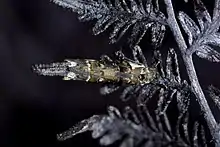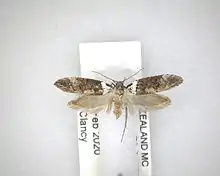| Trachypepla conspicuella | |
|---|---|
 | |
| Scientific classification | |
| Domain: | Eukaryota |
| Kingdom: | Animalia |
| Phylum: | Arthropoda |
| Class: | Insecta |
| Order: | Lepidoptera |
| Family: | Oecophoridae |
| Genus: | Trachypepla |
| Species: | T. conspicuella |
| Binomial name | |
| Trachypepla conspicuella | |
| Synonyms[2] | |
| |
Trachypepla conspicuella is a species of moth in the family Oecophoridae.[1][2] It is endemic to New Zealand and is found in both the North and South Islands. It is similar in appearance to its close relative T. euryleucota but tends to be paler. Its colouration imitates bird droppings. Larvae feed on leaf litter. Adults of this species are on the wing from November to February and have been observed resting on fences and walls.
Taxonomy
This species was first described by Francis Walker in 1864 and named Gelechia conspicuella using specimens collected in Nelson by T. R. Oxley.[3][2] In 1875 Baron Cajetan von Felder and Alois Friedrich Rogenhofer, thinking they were describing a new species, illustrated and named this species as Gelechia taongella.[4] In 1884 Edward Meyrick placed G. conspicuella within the genus Trachypepla and at the same time synonymised G. taongella.[5] George Hudson discussed and illustrated this species in his 1928 book The butterflies and moths of New Zealand.[6] The lectotype specimen is held at the Natural History Museum, London.[2]
Description
.jpg.webp)
Walker described the adults of this species as follows:
Male. Blackish, cinereous beneath, allied to Oecophora. Palpi blackish, stout, much longer than the breadth of the head ; third joint lanceolate, a little shorter than the second. Antennae smooth, much shorter than the fore wings. Thorax white, except in front. Abdomen cinereous. Tarsi with blackish bands. Wings rather broad, rounded at the tips ; fringe long. Fore wings brownish cinereous along the interior border (except towards the base) and on full one-third of the length from the exterior border ; a white band which is dilated on the interior border to the base of the wing, and has two black spots on the outer side ; a whitish transverse line at three-fourths of the length, much dilated in front, bordered with black on the inner side; exterior border slightly convex, very oblique. Hind wings aeneous-cinereous. Length of the body 3 lines ; of the wings 9 — 10 lines.[3]
This species is variable in appearance but can be recognised by its brown thorax and pale basal patch.[6] Darker specimens of this species can be confused with specimens of T. euryleucota.[6] Hudson was of the opinion that the colouration of T. conspicuella imitates bird droppings.[6]
Distribution
This species is endemic to New Zealand and can be found in the North and South Islands.[7][6] Other than the type locality of Nelson, this species has been collected at Wellington, Christchurch and Lake Wakatipu.[6][8]
Host species

Meyrick hypothesised that the larvae of this species may feed on moss.[9] However the larvae of T. conspicuella have been observed as feeding on leaf litter.[10][11] They have also been observed emerging from "nests" built by the larvae of Hierodoris atychioides.[11]
Behaviour
Adults are on the wing from November to February. This moth is frequently observed resting on human made structures such as fences or walls and is known to enter houses.[6]
References
- 1 2 Gordon, Dennis P., ed. (2010). New Zealand inventory of biodiversity: Kingdom animalia : chaetognatha, ecdysozoa, ichnofossils. Vol. 2. p. 462. ISBN 978-1-877257-93-3. OCLC 973607714. OL 25288394M. Wikidata Q45922947.
- 1 2 3 4 John Stewart Dugdale (23 September 1988). "Lepidoptera - annotated catalogue, and keys to family-group taxa". Fauna of New Zealand. Department of Scientific and Industrial Research. 14: 106. doi:10.7931/J2/FNZ.14. ISSN 0111-5383. Wikidata Q45083134.
- 1 2 Francis Walker (1864), List of the Specimens of Lepidopterous Insects in the Collection of the British Museum, Part XXIX. - Tineites, London, p. 651, Wikidata Q110191308
{{citation}}: CS1 maint: location missing publisher (link) - ↑ Felder, Cajetan; Rogenhofer, Alois Friedrich (1864–1867). "Reise der österreichischen Fregatte Novara". Reise der österreichischen Fregatte Novara um die Erde in den Jahren 1857, 1858, 1859 unter den Befehlen des Commodore B. Von Wüllerstorf-Urbair (in German). pt.9:Bd.2:Abt.2 (1864-1867) Atlas: Plate CHL fig 45 – via Biodiversity Heritage Library.
- ↑ Edward Meyrick (1884). "Descriptions of New Zealand Microlepidoptera. III. Oecophoridae". Transactions and Proceedings of the New Zealand Institute. 16: 15. ISSN 1176-6158. Wikidata Q63976486.
- 1 2 3 4 5 6 7 George Vernon Hudson (1928), The butterflies and moths of New Zealand, Illustrator: George Hudson, Wellington: Ferguson and Osborn Limited, pp. 283–284, LCCN 88133764, OCLC 25449322, Wikidata Q58593286
- ↑ "Trachypepla conspicuella (Walker, 1864)". www.nzor.org.nz. Retrieved 2022-03-04.
- ↑ Scott Hooson (27 January 2015). Christchurch District Plan Site of Ecological Significance Lake Forsyth North Side (PDF) (Report). Christchurch City Council. p. 16. Retrieved 25 May 2022.
- ↑ Edward Meyrick (1922). "Lepidoptera Heterocera. Fam. Oecophoridae". Genera Insectorum. 180: 58. Wikidata Q112113257.
- ↑ Graeme White (1991). "The Changing Abundance of Moths in a Tussock Grassland, 1962- 1989, and 50-Year to 70-Year Trends" (PDF). New Zealand Journal of Ecology. 15 (1): 5–22. ISSN 0110-6465. JSTOR 24054454. Wikidata Q107569572.
- 1 2 Brian Patrick; Ruud Kleinpaste (1 July 2014). "Moths from a conifer nest in Christchurch". The Wētā. 47: 39–46. ISSN 0111-7696. Wikidata Q105344868.